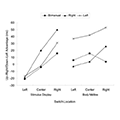Abstract
Two types of stimulus–response compatibility (SRC) effect occur with orthogonal stimulus and response sets, an overall up–right/down–left advantage and mapping preferences that vary with response position. Researchers agree that the former type is due to asymmetric coding of the stimulus and response alternatives, but disagree as to whether the latter type requires a different explanation in terms of the properties of the motor system. This issue is examined in three experiments. The location of the stimulus set influenced orthogonal SRC when it varied along the same dimension as the responses (Experiments 1 and 2), with the pattern predicted by the hypothesis that the stimulus set provides a referent relative to which response position is coded. The effect of stimulus-set location on orthogonal SRC was independent of the stimulus onset asynchrony (SOA) for a marker that indicated stimulus-set side and the imperative stimulus. In contrast, a spatial correspondence effect for the irrelevant stimulus-set location and response was a decreasing function of SOA. Experiment 3 showed that the orthogonal SRC effect was determined by response position relative to the stimulus-set location and not the body midline. The results support the view that both types of orthogonal SRC effects are due to asymmetric coding of the stimuli and responses.
